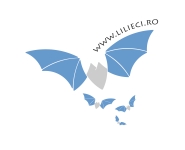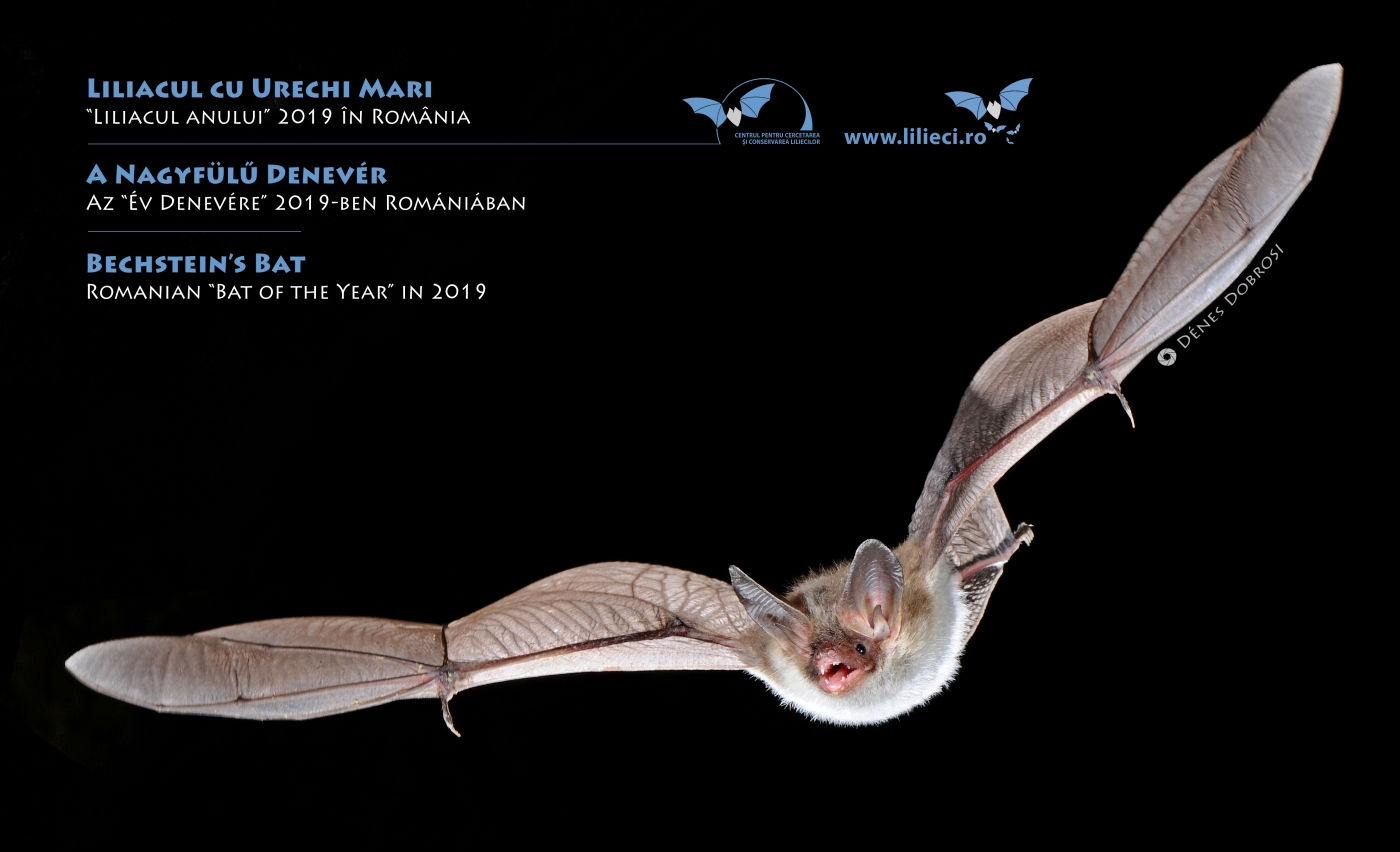Dear readers and bat enthusiasts, you have decided! The “Bat of the Year” 2019 in Romania is Bechstein’s bat (Myotis bechsteinii), a species who really appreciates ancient forests. From a total of 642 votes cast for the three finalists, Bechstein’s bat received 290 (45.2%). Schreiber’s bat (Miniopterus schreibersii) received 149 votes (23.2%), while the northern bat (Eptesicus nilssonii) received 203 (31.6%). Thank you to everyone who voted!
Bechstein’s bat
The one who really appreciates ancient forests
As it is stated in the subtitle, Bechstein’s bat favors secular forests, but also other old deciduous forests. This preference relates both to the use of hollow trees by colonies as roost, and to hunt for food in this habitat type. The presence of Bechstein’s bat indicates the exceptional quality of habitats and forests used by the species.
Myotis bechsteinii is a medium sized species from the Myotis genus, having proportionally the largest ears (more than 2 cm in lenght) among the species group. But compared to long-eared bats (yes, those with really gigantic ears), Bechstein’s bats have more modest sized ears. The fur on the dorsal side is brown / reddish-brown and is clearly darker than the light gray / white fur on the belly.
Colonies comprising 10-20, in rare cases 50 bats regularly use hollow trees, other elements of old grown trees (crevices, etc), or even bird boxes. Colonies use several hollows on a rotative basis, each for 2-3 days. During the winter Bechstein’s bat can be found in caves or other underground roosts, being one of the species that tolerates low temperatures. It is a sedentary species, with distances between summer and winter roosts of only a few kilometers.
Bechstein’s bat hunts at low altitudes of 1-5 m, close to vegetation, even at ground level in mature forests without significant understorey, or in the canopy. It has a very maneuverable flight, being even able to hover. The big ears have the role of very accurately detecting the sounds emitted by target insects. On the menu of Bechstein’s bat we find beetles, spiders, moths and other typical forest insects, a high percentage of which is unable to fly.
Regarding the distribution of the species in Romania, it was considered a rare species in the past, due to research focused primarily on visual observations inside caves, where the species is present only in hibernation seasons. However, based on more modern research carried out in the last decade with appropriate methods (mist-netting at cave entrances during the mating season, acoustic methods used in habitats), has provided a series of new distribution data, that highlighted the presence of the species in almost all regions of Romania.
Bechstein’s bat is threatened by habitat fragmentation and habitat loss, including the cutting of the hollow trees. Thus, for a real and sustainable conservation of the species, it is advisable to enhance the protection of secular deciduous forests, as well as the preservation of hollow trees (ex. 25-30 hollows / ha, or 7-10 hollow trees / ha). Keeping dead wood in the forest favors insect diversity, but it can also provide roosts for the species. The fact that the species uses a network of hollow trees strengthens the need to protect some habitats as a whole, functional unit.
Due to the fact that the species crosses open spaces with a very low flight, it is prone to a significant threat from road traffic. Thus, “duck-under” type green passages are of high importance. Similarly, keeping linear elements in the habitat (ex. tree rows, hedgerows, etc.) maintains the connection between other habitat elements (ex. between roosts and feeding areas), thus maintaining a generally high habitat permeability. As in case of other bat species, it is also important to keep water surfaces in or near forests, these serving as feeding habitats and water sources, as well as flight routes.
Conservation status (IUCN):
- Global status: near threatened (NT)
- Global trend: decreasing
- European status: vulnerable (VU)
- European trend: decreasing
Legislation:
- Law 13/1993 (Bern Convention)
- Law 13/1998 (Bonn Convention)
- Law 90/2000 (EUROBATS)
- Law 49/2011 (Habitats Directive)
- MO 656/2014
Recommended reading (also used partially in the above text):
- Ministerial Ordinance 656/2014, for approving the regional action plan for the management of Rhinolophus ferrumequinum, Rhinolophus hipposideros, Myotis myotis, Myotis oxygnathus, Myotis bechsteinii, Barbastella barbastellus, Miniopterus schreibersii.
- Dietz, C., Kiefer, A. (2016): Bats of Britain and Europe. Bloomsbury Publishing, United Kingdom. pp. 400.
- Jére Cs., Bücs Sz. (2013): Bats and management of underground roosts – methodological guide [booklet written in Romanian]. Project “Bat conservation in Pădurea Craiului, Bihor and Trascău Mountains” LIFE08/NAT/RO/000504. pp. 40.
- Paunović, M. (2016): Myotis bechsteinii. The IUCN Red List of Threatened Species 2016: e.T14123A22053752. Downloaded on 04 March 2019. https://www.iucnredlist.org/species/14123/22053752
- Schlapp, G. (1999): Myotis bechsteini. In: A. J. Mitchell-Jones, G. Amori, W. Bogdanowicz, B. Kryštufek, P. J. H. Reijnders, F. Spitzenberger, M. Stubbe, J. B. M. Thissen, V. Vohralík and J. Zima (eds), Atlas of European Mammals, Academic Press, London, UK.
To resume
In November – December 2018, there was a brief debate and a pre-selection within the bat expert community of Romania, where we agreed on three Romanian bat species (out of a total of 32). They became the three finalists for the 2019 edition of the competition. They are:
- Schreibers’ bat, forming the largest bat colonies of Romania
- Bechstein’s bat, the one who really appreciates ancient forests
- The northern bat, the one enduring the lowest temperatures
The vote ran until February the 10th, till 24:00, when, based on the votes cast to each finalist, we jointly designated the winner of the title “Bat of the Year 2019”. And throughout 2019 we focus our efforts on presenting to you as much as possible about the winning species. Thank you to everyone who voted!
You can aid our activities here: https://gogetfunding.com/for-bats-and-their-future/








